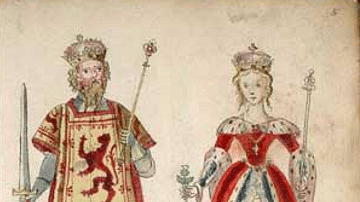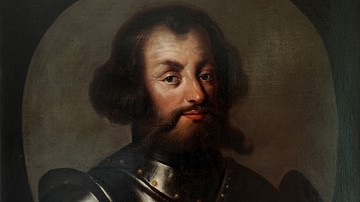
Saint Margaret of Scotland (c. 1046-1093 CE) was, as the second wife of Malcolm III (r. 1058-1093 CE), the queen of Scotland from 1070 CE until her death in November 1093 CE. A princess of the royal house of Wessex, she brought Anglo-Saxon cultural practices to Scotland and promoted Roman Catholicism in her adopted kingdom. Three of Margaret's sons ruled as kings of Scotland while her daughter became queen of England as the wife of Henry I of England (r. 1100-1135 CE). Margaret was made a saint in 1250 CE for her services to the Catholic Church and the poor in Scotland.
Early Life
Margaret was born around 1046 CE, and she had real royal pedigree. A princess of the House of Wessex, she was the elder sister of Edgar Ætheling, and their father was Edward the Exile (d. 1057 CE), their grandfather Edmund Ironside (r. Apr-Nov 1016 CE), and their great-grandfather was King Ethelred II of England (r. 978-1013 & 1014-1016 CE). Finally, their great-uncle was Edward the Confessor (r. 1042-1066 CE). Margaret's father was exiled following the seizure of the English throne in 1016 CE by Cnut the Great (r. 1016-1035 CE). Consequently, the family went to reside in Hungary. Margaret's mother, Agatha, was in some way connected with the Hungarian royal house (although her parentage is much-debated amongst scholars). Margaret was born at Réka Castle near Mecseknádasd in southern Hungary. When her brother Edgar was recalled to England as a possible heir to the English throne in 1057 CE, Margaret went with him.
Edgar missed out on inheriting the throne of England following Edward the Confessor's death in 1066 CE because he was only in his teens and the Saxon lords preferred to back the military experience of Harold Godwinson (r. Jan-Oct 1066 CE). Then Harold was killed in 1066 CE at the Battle of Hastings against William the Conqueror. The Norman duke became William I of England (r. 1066-1087 CE) and embarked on his long but ultimately successful Norman Conquest of England. Saxon rebels chose Margaret's brother Edgar as their figurehead and candidate number one to replace the Norman king if an opportunity arose. The Normans proved impossible to shift, though, and William secured his new throne by defeating rebellions in various parts of his realm, including the north of England. Edgar did not give up hope, and in 1068 CE he sought shelter in Scotland, taking with him his mother, Margaret and his other sister, Cristina (d. c. 1100 CE).

Marriage to Malcolm III
In 1059 CE Malcolm III of Scotland had married Ingibiorg, the widow of Thorfinn of Orkney, but she died a decade later. In 1070 CE Malcolm decided to marry Margaret, despite her original intention to become a nun. Margaret's sister Cristina did become a nun, and then the abbess of Romney Abbey in southern England. The marriage added further risk to Malcolm's position as host to a dangerous rival to William I's throne in England. The threat would be made even worse if and when Malcolm and Margaret had children who then might stake a claim to the crown of England. Several times already, Saxon and Danish lords had combined to see if they could wrest the north of England from Norman control. Edgar Ætheling continued to be their nominal figurehead and cloak of legitimacy, for he, they claimed, was still the rightful king of England.
In 1070 CE Malcolm unwisely ravaged Yorkshire. William I eventually put an end to the troublesome raids on northern England with a combined land and sea operation in 1072 CE. Scotland itself was threatened, and Malcolm, whose army was no match for the disciplined Norman cavalry, sued for peace before any battle broke out. The terms, known as the Abernethy agreement, included Malcolm swearing allegiance to William as the superior monarch, providing Duncan (his son with Ingibiorg) as a hostage, and ensuring Edgar's exile to Flanders (where died in obscurity around 1125 CE).
Malcolm and Margaret had eight children; the most important in terms of future Scottish history were: Edgar (b. c. 1074 CE), Alexander (b. c. 1077 CE), Edith (1080-1118 CE), and David (b. c. 1084 CE). The high number of pregnancies and her own austere lifestyle undoubtedly took many years off Margaret's life.
English Influence in Scotland
Margaret is often attributed as the prime cause of the increase in Anglo-Saxon influence in Gaelic Scotland. This anglicisation may be exaggerated, and have really only concerned the royal court at Dunfermline or (in a view favoured by most modern historians) been largely instigated by Malcolm's successors, his three sons with Margaret who ruled in turn from 1087 to 1153 CE. It should also be remembered that Malcolm had himself spent his youth in England following his exile there after the death of his father Duncan I of Scotland (r. 1034-1040 CE). He had resided in York at the court of Siward, earl of Northumbria (r. 1041-1055 CE). Malcolm had not returned to Scotland until he was in his early twenties in 1054 CE when, with the support of Siward and the English king Edward the Confessor, he attempted to regain his family's hold on the throne of Scotland. With the death of Macbeth, king of Scotland in 1057 CE, and then his son Lulach in 1058 CE, Malcolm did finally become Malcolm III of Scotland.
Certainly, Margaret must have had some influence at court as Malcolm doted on his wife, 15 years his junior. The queen did not learn Gaelic, for example, and made English the language of the royal household. Margaret also ensured many of her children were given traditional Saxon names. She may well have introduced English court customs, ideas of display, art, clothing, and even hairstyles to the royal court. It is perhaps relevant that Margaret and Malcolm were grooming their children to become not only monarchs in Scotland (their eldest son was nominated Malcolm's successor, not any of his children with Ingibiorg) but hopefully, too, in England if William the Conqueror could be forced back to Normandy. An education in English ways would serve them well if the Wessex line was to be restored on the English throne.

More certain is Margaret's effect on Christianity in Scotland, although just how big an effect is still debated amongst scholars. Queen Margaret was a keen supporter of the Catholic Church, and her promotion of it continued the demise of Gaelic Christianity in Scotland. This was an ongoing and lengthy process of substitution which had already been happening in the reign of Malcolm's predecessors. Macbeth, for example, had gone on a pilgrimage to Rome in 1050 CE.
Margaret regarded some of the practices and certainly the organisation of the church in Scotland rather backward compared to her experience in both Hungary and England. English Benedictine monks and a number of priests were invited to reside in Scotland, particularly Dunfermline, to spread the faith and establish monasteries which could act as spiritual guides to the commoners. Margaret corresponded with Lanfranc, the Archbishop of Canterbury in England for him to send monks across the border. Margaret was generous to the poor, establishing endowments and funding the construction of places of rest for pilgrims. The queen also gave grants to several churches, notably at Laurencekirk and Iona in the Inner Hebrides, the traditional burial site of Scottish monarchs.
Death & Sainthood
Malcolm III was killed during a raid on Northumberland on 13 November 1093 CE. Malcolm and Margaret's son Edward died in the same incident. Queen Margaret, then in Edinburgh castle, was already very weak from a period of fasting, but she lived long enough to hear this terrible news and then died on 16 November. She was buried at Dunfermline in a small church she had herself funded the construction of and which later became part of Dunfermline Abbey where a shrine was built in her honour in the mid-13th century CE.

Margaret's children were forced into exile in England as a backlash began against English influence in Scotland. Malcolm's younger brother became king, Donald III of Scotland (r. 1093-1097 CE). Margaret's children would reclaim their birthright, though. First was Edgar who, with the help of William II of England (r. 1087-1100 CE), became Edgar, King of Scotland (r. 1097-1107 CE). Two more of Margaret's sons would, in turn, inherit the throne as Alexander I of Scotland (r. 1107-1124 CE) and David I of Scotland (r. 1124-1153 CE). Meanwhile, as the royal houses of England and Scotland became closer allies, in 1100 CE Margaret's daughter Edith became the first queen of Henry I of England and changed her name to a more suitable Norman one, Matilda.
Queen Margaret was remembered with her own Norman chapel in Edinburgh Castle, today the oldest original part of that fortress. Margaret's daughter Edith/Matilda ensured her mother's good deeds were recorded in a decidedly hagiographic biography, written by Turgot of Durham (c. 1050-1115 CE), a benedictine monk and once Margaret's personal chaplain. In 1250 CE Margaret was made a saint by the Catholic Church in recognition of her efforts to spread Roman Catholicism and her charity work for the poor in Scotland. For this reason, she is today better known as Saint Margaret of Scotland.





